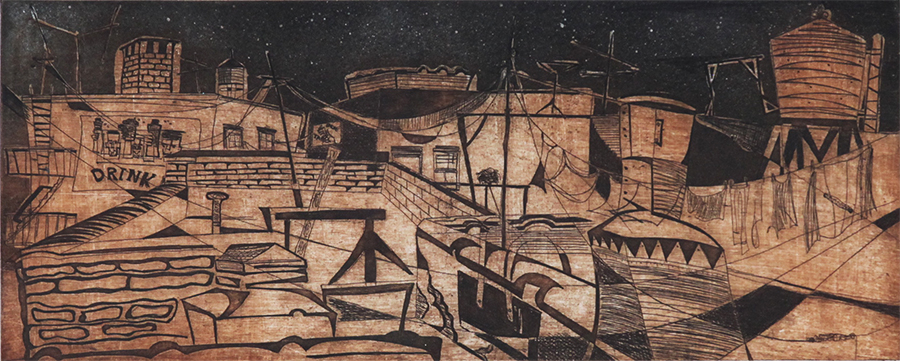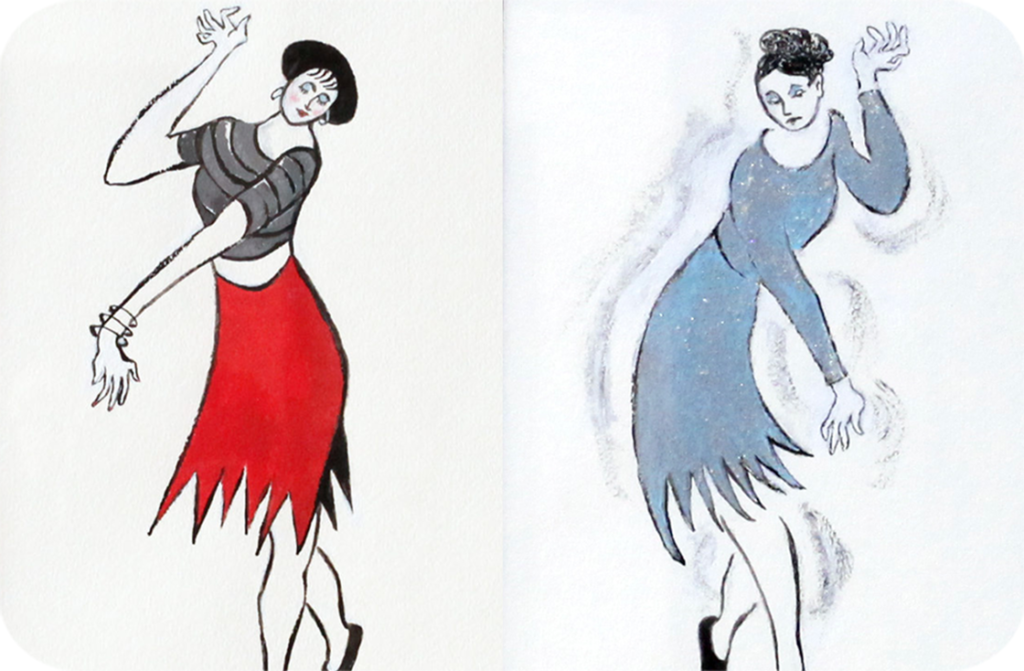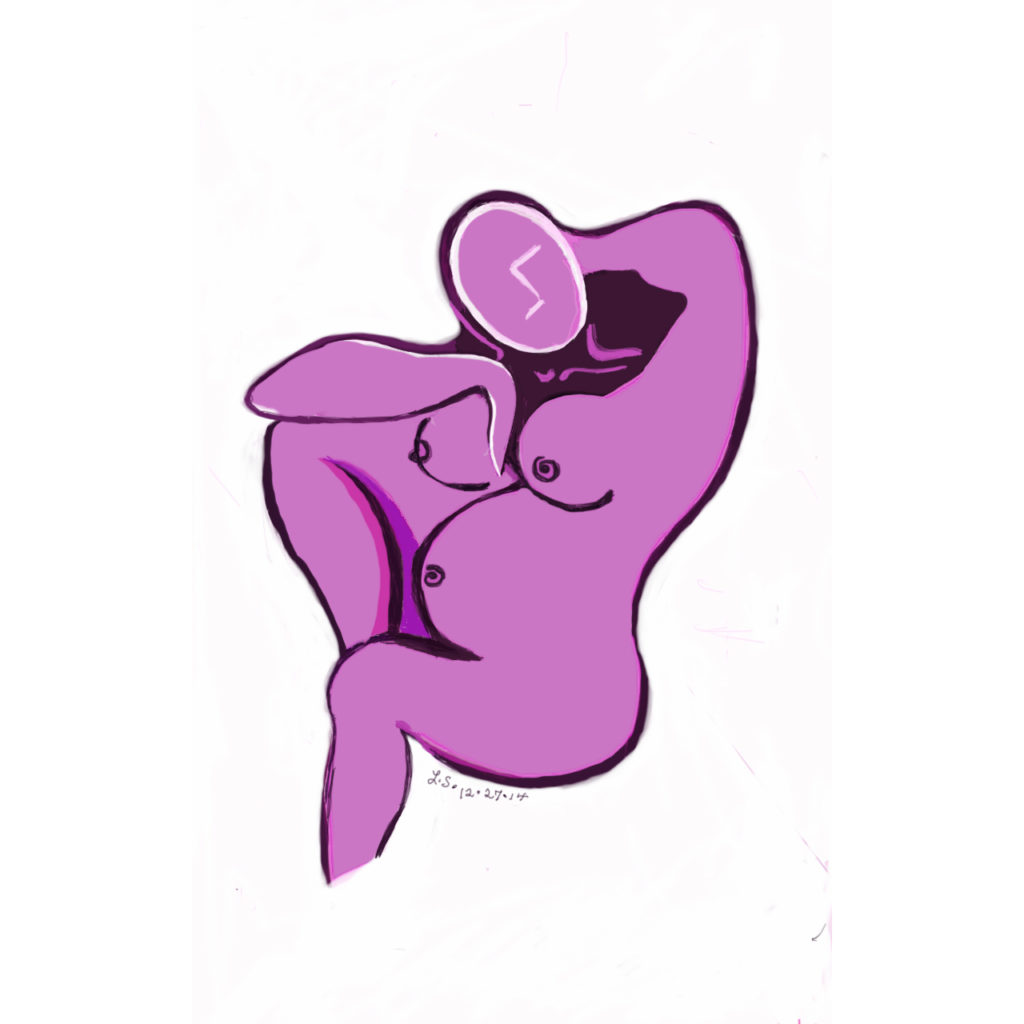A Conversation With Lenore Simon

In this exclusive interview with renowned artist Lenore Simon, we talked with her about her inspiration, her beginnings in New York and New Jersey, and her move West to San Diego.
.
SG: People want to know, when did you become a professional fine artist?
LS: The criteria is usually having sold something. They didn’t train us to deal with that element in our studies when we went to art school. We didn’t learn about commissions and we didn’t learn about the marketing aspect, but I had a friend who fell in love with one of my strongest pieces, my “night spot” and I couldn’t handle the idea of accepting money, not only because she was a friend but just dealing with the transaction I found very discomforting. Finally she said to me, “if you won’t accept any money, I won’t accept the piece.” I said, “well, ok, $45 but I’ll only accept it if I use it to sign-up for a printmaking workshop.” You know somebody else might have decided to have their hair done or blow it on a new outfit. I made a commitment because I really felt that printmaking was my first love in high school and I was probably the only individual who took a post graduate from high school. I actually stayed for an additional year to study printmaking because they owned an etching press. I feel that experience gave me an edge over a lot of people in terms of building my background in helping hone my skills.

Going on from there, I would say the next criteria apart from selling a piece of artwork would be having a show. And fortunately I had a cousin who rented out space at the Coliseum in New York and gave me a section where I could display my art work. So that made me at least a good beginning professional fine artist.
(In her 30s Simon had two small children.)
.
I put my art on a back-burner playing the role of what I thought was “mommy” and somewhat good wife to my husband who was the main bread winner at the time. It was when my kids were roughly six and eight that I did my first painting since high school. It was a painting that I did on a wooden table. I didn’t have any supplies so I used spackle as the surface, as the primer, and I used my kids’ tempera paint, and I didn’t have any decent brushes, so I took some sticks and I used sticks to apply the paint.
I lived in what was a bedroom community – it was New York’s bedroom so to speak – on the West side of the George Washington Bridge in Teaneck New Jersey where we had our first home. And it’s when my kids were six and eight that I finally had my work displayed and then after that I joined an art group, FACT, the Fine Arts Committee of Teaneck. This group of artists were long time professionals, and we did display our work. At that time I was recognized in the press as part of the group as an artist who “can and does draw posters at the drop of a magic marker” – I used to be the ones who made the posters for school.

SG: Can we talk a little more about your early history growing up in New Jersey and New York in the 1930s?
LS: Going back to my elementary school days, I was a depression era kid, and it’s nothing to be depressed about, it’s something to feel very positive about. Because of what was happening during those years, it was very difficult for landlords to find people to rent, that they would lure them by offering a free month’s rent for a free paint job. So I can remember the smell of fresh paint and going from Publics 46 to 86 back to 46 back to 86, going back and forth. I never could catch-up academically, but my one sustaining talent was my ability to draw. And that’s where I got a lot of attention from my teachers, where they’d ask me to do posters and they would borrow me from another teacher.
Fortunately, when I was playing out on the street, as most kids did – we sat on the front of the sidewalk and we played jacks,and the boys were playing their baseball – I met a young lady who went to an alternative school. She told me about the high school that she went to in Manhattan. Which meant I had to go by subway 45 minutes to get to school. But luckily this was a school where the teachers were not academicians, they were all professional fine artists. So I was able to study with people when I was 13, learning about the Bauhaus, something most students don’t learn about until they’re in college. So I had not only this wonderful foundation but there were teachers who were fine artists. One was Robert Gwathmey, who had a show with Jacob Lawrence at the Museum of Modern Art. Another was a sculpture teacher who did the figures for the City of Hope. So these were highly accomplished artists and artisans. To this day I am still in contact with the children of my former art teachers. I feel very fortunate to have had this amazing background.

As I look through my brag book, one of millions, I see that I was – ah – after high school – I felt very insecure, I didn’t think I could make it because, as I said academically I felt I was very wanting. I was fearful that I wouldn’t get into college. Luckily, I was accepted to a college in Brooklyn, and that gave me the confidence to try for Cooper Union. So I took the test for Cooper Union and I learned later that they weren’t looking for people with the highest grades academically, they were looking for people who thought outside the box. And what they did is they actually tested you in various art forms.
I was required, for example, to create an architectural drawing. I remember doing a drawing of a theater marquis and I made it triangular, which I thought was pretty nifty. You could see it from two different sides. The other was to do a piece of sculpture, and I remember in the midst of my working on a piece of sculpture, someone had to go to a restroom, brushed by me, and the piece fell on the floor. I picked it up, somewhat horrified, and looked at it and I said, “it’s a bird!” It suggested a bird, and so I went with it. Sure enough, I got into Cooper Union! And fortunately I had the benefit of equally wonderful art teachers and those who encouraged me tremendously to go beyond where I was in high school and college and to apply my trade.

One of my teachers, who happened to be the co author of a book called “The Complete Printmaker” John Ross and his wife Claire Romano, both taught at the New School, and Ross opened up an art school in Northern New Jersey. So, when I was willing to accept my friend’s $45, I enrolled in that school and actually ended up teaching some of the art classes there, while I was studying printmaking with John and other fine print makers in the evening.
And then I began to show, and compete, and did manage to get a few awards for printmaking and began to get enough confidence that when I did a drawing, for example I used to love to draw people by watching television & the interview shows with people like Dick Cavett. I remember on one occasion he interviewed Della Reese, so I made a drawing of Della and managed, through the benefit of my library, to find out how I could contact her and here I have this lovely note on her stationery. Not all my work was as nicely received, but I’m not going to mention any names.
I had this marvelous calligraphy teacher and he wrote the book on printmaking, a calligraphy bible. He was very astute in that he wouldn’t give the entire class the same project. He would ask each student was their area of interest and I said mine was children. So he gave me two very interesting challenges, one was to design a poster for a circus and the other was to design an alphabet. But I couldn’t simply do A is for apple, the letter had to have an illustration that conformed to the shape of the letter – for example, “t was for totem pole” it was such a wonderful right / left brain challenge that to this day – I am approaching 90 – I am still giving gifts of that alphabet that I personalize when my friend’s have grandchildren. I am still using that alphabet to make people happy.

SG: You mentioned before that you moved to San Diego in the late 1960s. How was the transition for you artistically?
LS: I feel good about the fact that Mark Elliott Lugo, who is now retired and who used to curate the shows at the Earl & Birdie Taylor Branch Library at Pacific Beach, had been the juror for an exhibition I had installed at the La Jolla art association. I fell madly in love with him despite the fact that he was years my junior. He wrote a two page article in the Tribune and gave us four stars, but he gave other art organizations only two or three stars. The title of his article was “Exhibit Of Children’s Art Is A Humbling Experience” and I thought, how wonderfully sensitive he was to the art in that show. The Tribune has been very kind to me.
Apart from promoting other children’s work and teaching a class at the La Jolla Library, I began to compete – and I see I also have some of my work that was included in a book published by North Light books, where I had to share some of my own personal secrets. That was an exciting element because not only did they give me four pages in the book, but it also showed examples of my work as well as sharing my secrets with artists. For example, one of my secrets was to use saran wrap to ink the surface of something that was three dimensional. By using the saran wrap, which had an element of flexibility, I could work off a three dimensional form and then transfer that ink form which would have been a negative image which would have been a positive image on my paper.

GS: It seems you were happy developing your artistic community and career here in San Diego.
LS: Absolutely! Another feather in my artist’s beret. I did join Artist’s Equity which had a chapter in CA, but I enjoyed an artists group in San Diego and we were very supportive of each other. I was very happy about the fact that the San Diego Museum of Art had an exhibition which featured art done by print makers and featured three of my works.
Ultimately I was very successful in having received eight individual artist in residency grants, so that pretty much established in my mind that I was a professional fine artist.
My helpmate was my husband Bob. I had him drag around my portfolios during my early days as an art student. Later on, I felt in a way I was instrumental in his achieving his goal to become a licensed clinical psychologist, and he used as his subjects (someone else would say guinea pigs) well over 30 – perhaps 130 – of my printmaking colleagues to study the creative personality. It was very interesting to me to read his dissertation years later and find out some of the things that contributed to his developing a tremendous respect for fine artists. So it was interesting that Jan Jennings of the Tribune wrote another very lengthy article that says “the twain meet in marriage of artist psychologist”.

I did believe that in the art community we were supportive of one another, and I invited colleagues of mine to share space at the Unitarian church where they had a wonderful gallery and we had a piece, which I suggested “Pieces of 8” (eight works by 8 different artists). So we began to get reviews and that was always satisfying. Ultimately, I was able to receive nice commentary from various people in a brochure produced by a dear friend of mine, whose work I fell in love with before I met him. He used to do album covers for Columbia records. I thought those covers were so stunning, and I used to look to see who did them. I found out they were done by a young man named Ernest Socolov. We met in Teaneck New Jersey when his wife Florence and I met pushing strollers.


